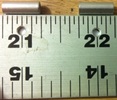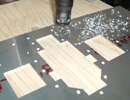


random user submitted photo
Fuel efficiency sonex ?
12 posts
• Page 1 of 2 • 1, 2
Fuel efficiency sonex ?
Hello,
I really love the sonex and have the long term project to build one for cross-country (looking for a plane to do 500 km leg as fast and economical as possible ).I was wondering if someone could give me feedback on fuel efficiency ? I search this forum but couldn't find a clear answer.
Sonex website claims a fuel efficiency of 42 miles per galons a 150 mph TAS at 8000 feet with the Aerovee engine for the sonex-b, is this realistic? feel like too good to be true. Also at which speed do you get your best mileage ?
Thanks a lot in advance
Vincent
I really love the sonex and have the long term project to build one for cross-country (looking for a plane to do 500 km leg as fast and economical as possible ).I was wondering if someone could give me feedback on fuel efficiency ? I search this forum but couldn't find a clear answer.
Sonex website claims a fuel efficiency of 42 miles per galons a 150 mph TAS at 8000 feet with the Aerovee engine for the sonex-b, is this realistic? feel like too good to be true. Also at which speed do you get your best mileage ?
Thanks a lot in advance
Vincent
- vdiallonort
- Posts: 5
- Joined: Sun Jan 09, 2022 5:14 am
Re: Fuel efficiency sonex ?
My numbers for decent endurance couple with fuel economy:
Legacy Sonex
Aerovee 2.1 @ 2,900rpm
6,000ft DA
90KIAS = 100 KTAS
4 US Gall = 15 litres/ hour
In still air that will get me 300 nautical miles = 555 km with an hour reserve.
--
But I do tend to fly a little faster and take a higher fuel burn
Legacy Sonex
Aerovee 2.1 @ 2,900rpm
6,000ft DA
90KIAS = 100 KTAS
4 US Gall = 15 litres/ hour
In still air that will get me 300 nautical miles = 555 km with an hour reserve.
--
But I do tend to fly a little faster and take a higher fuel burn
Graeme JW Smith
-

GraemeSmith - Posts: 939
- Joined: Sat May 18, 2019 8:58 am
- Location: RI
Re: Fuel efficiency sonex ?
Thanks a lot, is it a turbo aerovee or the 80 hp one ?
Regards
Vincent
Regards
Vincent
- vdiallonort
- Posts: 5
- Joined: Sun Jan 09, 2022 5:14 am
Re: Fuel efficiency sonex ?
Waiex A model with Jab3300, Prince prop and Bing carb. 9 years and 360 hours of flying it. At 3000 ASL I average 143mph indicated and 4.9 gph fuel burn rate (premium auto fuel almost exclusively used) at about 2825 - 2850 rpm. It's a little over 29 mpg mathematically and I've tested and confirmed the reality quite a few times over the years. Personally, when I get about 300 miles down the road on a trip - I'm looking for a place to drop in for a comfort break and to refuel, I hate to push the boundaries on either the fuel bladder or my own... :)
Lorin
Lorin
- ldmill
- Posts: 90
- Joined: Mon Nov 21, 2011 2:30 am
Re: Fuel efficiency sonex ?
Thanks a lot, really good to have a reality check.Although it's far from the numbers of the website it's still nice efficiency. Maybe they use peculiar setup to get the 42 miles per gallon efficiency. Do you thing flying at 8000 ft would have improve your figures ?
Regards
Vincent
Regards
Vincent
- vdiallonort
- Posts: 5
- Joined: Sun Jan 09, 2022 5:14 am
Re: Fuel efficiency sonex ?
I keep track of all of my costs and operating numbers on my taildragger-equipped Jabiru 3300 powered Waiex.
Taking the GPS mileage between my oil changes and the gallons that I put in, I'm always at about 26 mpg. This includes taxi, run-up ect. It's a raw figure. I almost always operate in the low end of the cruise power envelope.
I've not gone to great lengths to pin down all of the numbers with precision but these are my best guesses...
Max power(3000 rpm+) 160 mph true, 7.0 gph, 22.9 mpg
High cruise (2850-2950 rpm) 150 true, 6.2 gph, 24.2 mpg)
Mid-cruise (2750-2850 rpm) 145 true, 5.7 gph, 25.4 mpg
Low cruise (2550-2750 rpm) 135 true, 5.0 gph, 27.0 mpg
Emergency long distance (1900 rpm), 100 true, 3.1 gph, 32.3 mpg
Taking the GPS mileage between my oil changes and the gallons that I put in, I'm always at about 26 mpg. This includes taxi, run-up ect. It's a raw figure. I almost always operate in the low end of the cruise power envelope.
I've not gone to great lengths to pin down all of the numbers with precision but these are my best guesses...
Max power(3000 rpm+) 160 mph true, 7.0 gph, 22.9 mpg
High cruise (2850-2950 rpm) 150 true, 6.2 gph, 24.2 mpg)
Mid-cruise (2750-2850 rpm) 145 true, 5.7 gph, 25.4 mpg
Low cruise (2550-2750 rpm) 135 true, 5.0 gph, 27.0 mpg
Emergency long distance (1900 rpm), 100 true, 3.1 gph, 32.3 mpg
Kip
2010 Waiex 0082 (first flight May 2010)
Jabiru 3300 #1637 and #3035
Dynon D-180
Becker radios
Garmin GDL 82 ADS-B
1175 hours
48 states visited
Based near Atlanta
Also flying a...
2000 Kolb Firestar II, Rotax 503, 575 hours
2010 Waiex 0082 (first flight May 2010)
Jabiru 3300 #1637 and #3035
Dynon D-180
Becker radios
Garmin GDL 82 ADS-B
1175 hours
48 states visited
Based near Atlanta
Also flying a...
2000 Kolb Firestar II, Rotax 503, 575 hours
- N111YX
- Posts: 711
- Joined: Fri Jun 03, 2011 9:43 am
- Location: Atlanta, GA USA
Re: Fuel efficiency sonex ?
Thanks a lot for all these numbers
- vdiallonort
- Posts: 5
- Joined: Sun Jan 09, 2022 5:14 am
Re: Fuel efficiency sonex ?
Straight line miles from where we used to live in Michigan to Key West is almost exactly 1300 miles. The drive would put almost exactly 1700 miles on the Buick's trip meter.
Chett (Waiex #212) gets 115mph out of 3.5gal of gas. As an airplane, Chett gets just shy of 33mpg. Factor in the twists and turns, not to mention the ups and downs, and you could argue we're getting nearly 43mpg. Better than advertised.
Funny thing that advertising.
Chett (Waiex #212) gets 115mph out of 3.5gal of gas. As an airplane, Chett gets just shy of 33mpg. Factor in the twists and turns, not to mention the ups and downs, and you could argue we're getting nearly 43mpg. Better than advertised.
Funny thing that advertising.
- Area 51%
- Posts: 804
- Joined: Thu Feb 18, 2016 7:57 am
Re: Fuel efficiency sonex ?
vdiallonort wrote:Thanks a lot, is it a turbo aerovee or the 80 hp one ?
Regards
Vincent
80hp - oh and a Prince-P tip prop
Graeme JW Smith
-

GraemeSmith - Posts: 939
- Joined: Sat May 18, 2019 8:58 am
- Location: RI
Re: Fuel efficiency sonex ?
I fly across Alabama pretty often at full throttle. I prefer to fly around 3500 feet for the trip, but turbulence often means I end up around 6500 feet. It can take a while to cruise climb up that high. I take off at around 1000-1050 lbs.
This is what a typical trip looks like:
250 miles in 2:00 = 125mph average. (For the level portion of the flight, I average around 135mph).
I refuel with 9-10 gallons after landing = 25-28mpg or 4.5-5.0gph for the trip.
In my opinion, Sonex's 8000 feet numbers are always a bit optimistic. You also need to keep in mind that it will likely take a long time to climb to 8000 feet if you're anywhere near sea level. This will adversely affect your overall performance.
Assuming these numbers from the website:
Physics implies the high altitude airplane is flying with a power setting of 115% relative to the low altitude airplane assuming the density at 8000 feet is 75% of the low altitude density (75% * (150/130)^3 = 1.15). Instead, when you convert their numbers to fuel flow rates, you get 3.78 gph and 3.57 gph, meaning the high altitude airplane is really at a relative power setting of 94% (assuming theirs not some huge improvement in fuel consumption). To be physically consistent, the high altitude airplane would be about "140mph TAS @ 39mpg".
I still feel like both sets of numbers are optimistic on fuel flow. To generate 80hp, you need to burn somewhere around 5.5 gph. Their low altitude example is then only at 70% power. In my airplane, I'm closer to 90% power at this speed and around 26 mpg.
This is what a typical trip looks like:
250 miles in 2:00 = 125mph average. (For the level portion of the flight, I average around 135mph).
I refuel with 9-10 gallons after landing = 25-28mpg or 4.5-5.0gph for the trip.
In my opinion, Sonex's 8000 feet numbers are always a bit optimistic. You also need to keep in mind that it will likely take a long time to climb to 8000 feet if you're anywhere near sea level. This will adversely affect your overall performance.
Assuming these numbers from the website:
Low altitude: 130 mph TAS @ 34.375 mpg
8,000': 150 mph TAS @ 42 mpg
Physics implies the high altitude airplane is flying with a power setting of 115% relative to the low altitude airplane assuming the density at 8000 feet is 75% of the low altitude density (75% * (150/130)^3 = 1.15). Instead, when you convert their numbers to fuel flow rates, you get 3.78 gph and 3.57 gph, meaning the high altitude airplane is really at a relative power setting of 94% (assuming theirs not some huge improvement in fuel consumption). To be physically consistent, the high altitude airplane would be about "140mph TAS @ 39mpg".
I still feel like both sets of numbers are optimistic on fuel flow. To generate 80hp, you need to burn somewhere around 5.5 gph. Their low altitude example is then only at 70% power. In my airplane, I'm closer to 90% power at this speed and around 26 mpg.
- gammaxy
- Posts: 600
- Joined: Wed Sep 04, 2013 9:31 am
12 posts
• Page 1 of 2 • 1, 2
Who is online
Users browsing this forum: No registered users and 29 guests







